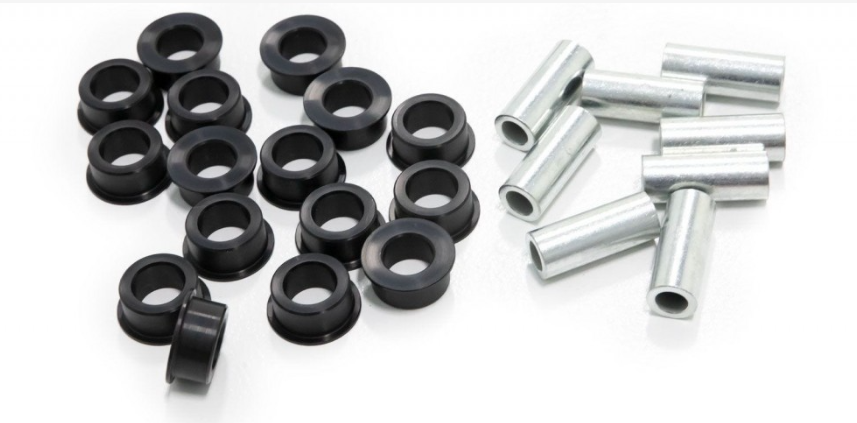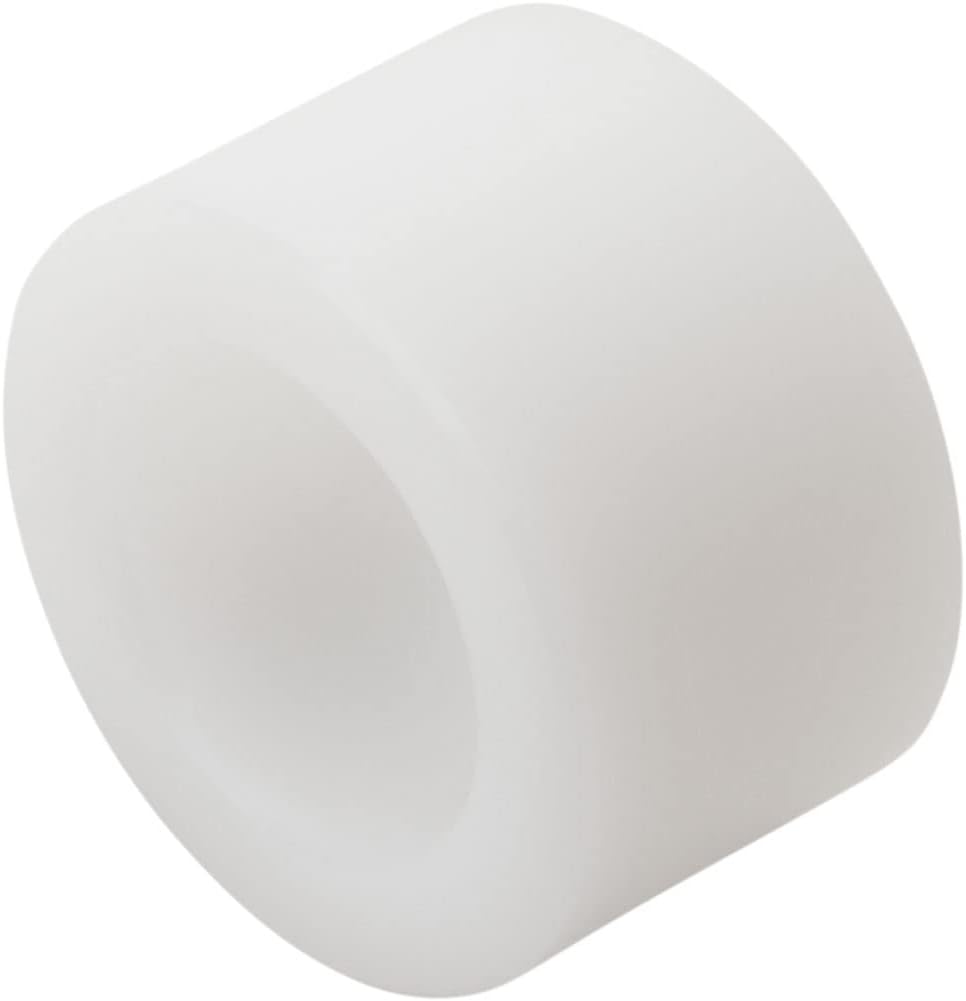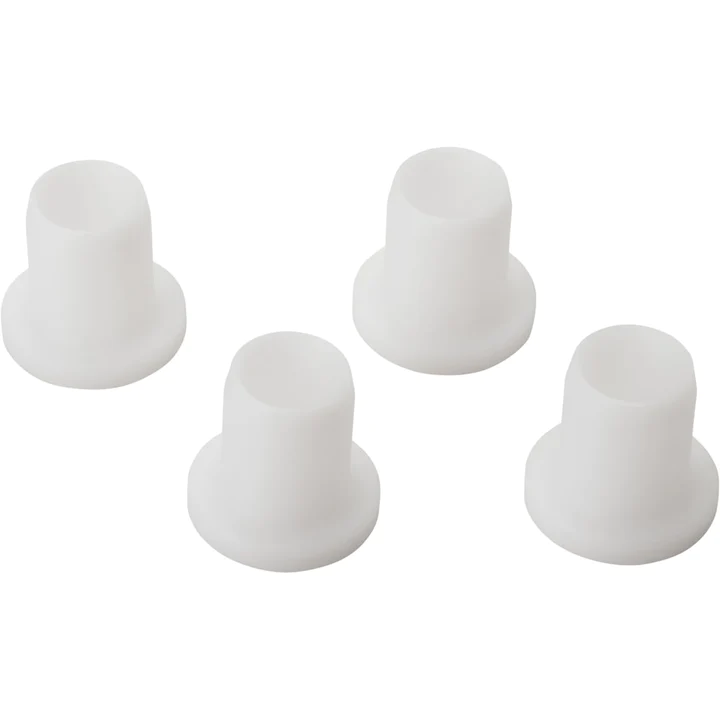Product Description
Customized Plastic Bushing
|
Product Name: |
Plastic bushing |
|
Application : |
Domestic electrical, automotive ,engineering machinery ,industry ,etc |
|
Material: |
Nylon PA6, Nylon, ABS, POM,PTFE |
|
Color: |
Black/white/yellow or others |
|
Material Density: |
1.25~1.64g/cm3 |
|
Max PV value : |
0.27~1.40 N/mm²·m/s |
|
Tensile Strengthen: |
40~90MPa |
|
Hardness: |
72~90 HRR |
|
Thermal conductivity: |
0.24 W/(m·k) |
|
Friction: |
0.08~0.26 |
|
Working Temperature: |
-80~+240ºC |
|
In addition to the standard product catalog is displayed, we provide non-standard product or to order according to customer requirements. |
|
Packing & Delivery
1. Inner Packing For small products: 100pcs-200pcs per sealed plastic bag. For bigger products: 2pcs-10pcs per plastic film roller (depends on the product size)
2. Outer Packing&Shipment Packing
8pcs-300pcs per carton (depends on the product size)
18-24 cartons per wood case or pallet, shockproof and safe for transportation.
Company Profile
Our Factory
FAQ
Q: Are you trading company or manufacturer?
A: Our management is focused on exporting activities for more than 10 years and we have our own bushing factory. CHINAMFG is always professional and reliable. Our advantages are multiple resource integration, strong quality assurance and excellent service level. We are always responsible for our products
Q: Hong long is your delivery time?
A: Generally 10-25 days after order. It depends on the quantity.
Q: Do you produce samples? Is it free or extra?
A: For standard products, we produce samples free of charge for our customers. And the express costs will be burdened by the customer, but can be returned after the order is placed.
Q: How to ensure the quality?
A: We produce as per the confirmed technology or drawings for each order for our customers. And our factory has a strict quality control system. We inspect goods during production according to a certain frequency and we also perform the final inspection before the goods are packed.
Q: Do you like to serve the customers only with small orders?
A: We are always glad to grow up together with all our customers whatever big or small.
We hope our customers become stronger and stronger to be with us.
/* January 22, 2571 19:08:37 */!function(){function s(e,r){var a,o={};try{e&&e.split(“,”).forEach(function(e,t){e&&(a=e.match(/(.*?):(.*)$/))&&1
| Customized: | Customized |
|---|---|
| Certification: | ISO, ISO 9001:2015 |
| Standard Parts: | Standard and Non Standard |
| Customization: |
Available
| Customized Request |
|---|
.shipping-cost-tm .tm-status-off{background: none;padding:0;color: #1470cc}
| Shipping Cost:
Estimated freight per unit. |
about shipping cost and estimated delivery time. |
|---|
| Payment Method: |
|
|---|---|
|
Initial Payment Full Payment |
| Currency: | US$ |
|---|
| Return&refunds: | You can apply for a refund up to 30 days after receipt of the products. |
|---|

Can UHMW bushings reduce friction and noise levels in machinery?
Yes, UHMW (Ultra-High Molecular Weight Polyethylene) bushings can effectively reduce friction and noise levels in machinery. Here’s a detailed explanation:
UHMW is known for its excellent self-lubricating properties and low coefficient of friction, which make it an ideal material for reducing friction in machinery. When used as bushings, UHMW can provide the following benefits:
Friction Reduction:
UHMW bushings exhibit a low coefficient of friction, meaning they have a reduced tendency to stick or generate excessive resistance when in contact with other surfaces. The low friction characteristics of UHMW help to minimize the amount of energy required for the movement of machinery components, resulting in smoother operation and reduced frictional wear.
Noise Reduction:
UHMW bushings can contribute to noise reduction in machinery. The self-lubricating properties of UHMW reduce the occurrence of friction-induced vibrations and chatter between moving parts. By minimizing these sources of noise, UHMW bushings help create quieter operating conditions in machinery.
Vibration Damping:
UHMW has excellent vibration-damping properties. When used as bushings, it can help absorb and dampen vibrations generated during machinery operation. This can be particularly beneficial in applications where excessive vibrations can lead to equipment damage or affect the accuracy and performance of sensitive components.
Smooth Operation:
Due to its low friction characteristics, UHMW bushings enable smoother and more efficient operation of machinery. They help reduce the likelihood of jerky or uneven movements, ensuring smoother transitions and improved overall performance.
Wear Reduction:
UHMW bushings have excellent wear resistance, which helps to minimize wear and extend the service life of machinery components. The low friction properties of UHMW reduce abrasive interactions between the bushings and mating surfaces, resulting in reduced wear and the need for less frequent maintenance or replacement.
It’s important to note that while UHMW bushings can effectively reduce friction and noise levels, the specific performance will depend on factors such as the design of the machinery, the load and speed of operation, and the proper selection and installation of the UHMW bushings. Additionally, regular inspection and maintenance of the machinery, including proper lubrication and replacement of worn bushings, are essential to ensure continued performance and noise reduction.
In summary, UHMW bushings can significantly reduce friction and noise levels in machinery. Their low friction properties, vibration-damping capabilities, and wear resistance make them an excellent choice for applications where smooth operation, noise reduction, and extended component life are desired.

Are there potential challenges or limitations to using UHMW bushings?
While UHMW (Ultra-High Molecular Weight Polyethylene) bushings offer many advantages, there are also potential challenges and limitations to consider. Here’s a detailed explanation:
1. Temperature Limitations:
UHMW bushings have a relatively low melting point compared to other engineering plastics. They can soften or deform at elevated temperatures, typically around 82°C (180°F) or lower, depending on the specific grade and formulation. If your application involves high temperatures, alternative materials or additional heat-resistant measures may be necessary.
2. Wear and Abrasion:
While UHMW has excellent wear resistance, it may not be suitable for applications with extremely abrasive conditions or high levels of impact. In situations where there are aggressive abrasive particles or substantial mechanical forces, alternative materials or protective measures, such as incorporating additional bearing surfaces or coatings, may be required.
3. Load and Pressure Limitations:
UHMW bushings have a relatively low compressive strength compared to metals and some other engineering plastics. They may not be suitable for applications with high loads or pressure requirements. Exceeding the recommended load or pressure limits can lead to premature wear, deformation, or failure of the bushings. Consideration should be given to the specific load and pressure conditions of your application and alternative materials may need to be considered for heavy-duty applications.
4. Creep and Relaxation:
UHMW has a tendency to exhibit creep or relaxation under continuous or long-term mechanical stress. This means that over time, the material may slowly deform or experience dimensional changes. It is important to consider the duration and magnitude of the applied stress in relation to the specific UHMW grade being used and the desired performance criteria. In applications where dimensional stability is critical, periodic monitoring and potential adjustments or replacements may be necessary.
5. Chemical Compatibility:
While UHMW is chemically resistant to many substances, it may not be compatible with certain chemicals or solvents. It is important to consider the specific chemical environment in which the bushings will operate and verify the compatibility of UHMW with the substances involved. In cases where chemical resistance is a primary concern, alternative materials may need to be considered.
6. Dimensional Stability:
UHMW bushings can exhibit slight dimensional changes due to factors such as moisture absorption or temperature variations. While these changes are relatively small compared to some other materials, they should be taken into account in applications where precise tolerances or tight clearances are critical.
7. Machining and Fabrication:
Although UHMW is generally considered to be a machinable material, it can present challenges during machining due to its low thermal conductivity and high coefficient of thermal expansion. Proper tool selection, cutting parameters, and machining techniques specific to UHMW should be employed to achieve desired results. Working with experienced manufacturers or fabricators who are knowledgeable about UHMW machining is recommended.
In summary, while UHMW bushings offer numerous advantages, it is important to be aware of potential challenges and limitations related to temperature, wear and abrasion, load and pressure, creep and relaxation, chemical compatibility, dimensional stability, and machining. By carefully assessing these factors in relation to your specific application requirements, you can make informed decisions and potentially address these limitations through alternative materials, modifications, or protective measures.

How do UHMW bushings compare to other types of bearing materials?
When comparing UHMW (Ultra-High Molecular Weight Polyethylene) bushings to other types of bearing materials, several factors come into play. Here’s a detailed comparison:
1. Friction and Wear:
UHMW bushings have a low coefficient of friction, resulting in reduced friction and wear. Compared to materials like metal or bronze, UHMW bushings offer superior self-lubricating properties, which reduce the need for additional lubrication. This self-lubricating feature minimizes friction, wear, and the associated maintenance requirements.
2. Load Capacity:
UHMW bushings have excellent load-bearing capabilities, particularly under high-load conditions. They can distribute the load evenly, reducing stress concentrations and minimizing the risk of premature wear or failure. However, certain metals like bronze or steel may have higher load capacities in specific applications.
3. Wear Resistance:
UHMW bushings exhibit excellent wear resistance, making them suitable for applications involving repetitive sliding or rubbing motions. They can withstand continuous use without experiencing significant wear. Materials such as bronze or steel may also offer good wear resistance, but UHMW bushings often outperform them in applications requiring low friction and self-lubrication.
4. Chemical Resistance:
UHMW bushings have high resistance to a wide range of chemicals, acids, solvents, and corrosive substances. This chemical resistance protects the bushings from degradation, making them ideal for applications in harsh environments. In comparison, metals like steel or bronze may be susceptible to corrosion or chemical attack.
5. Impact Strength:
UHMW bushings have excellent impact strength, allowing them to withstand high loads and absorb shocks effectively. They can handle heavy-duty applications and resist deformation or failure even under significant impact forces. Other materials like bronze or steel may have varying levels of impact strength depending on their composition.
6. Temperature Resistance:
UHMW bushings have good temperature resistance, maintaining their properties over a wide temperature range. They can withstand both low and high temperatures without significant dimensional changes or loss of performance. In contrast, certain metals may have higher temperature tolerances but may exhibit thermal expansion or contraction.
7. Machinability:
UHMW bushings are relatively easy to machine, allowing for the creation of bushings with precise dimensions and tolerances. However, metals like bronze or steel can offer greater machining versatility and precision due to their inherent properties.
8. Cost:
UHMW bushings are generally cost-effective compared to many other bearing materials. They offer a long service life, reduced maintenance requirements, and resistance to wear and tear, contributing to overall cost savings. Metals like bronze or steel may have higher upfront costs but can be more economical in certain high-load or extreme temperature applications.
It’s important to note that the suitability of a bearing material depends on the specific application requirements. Factors such as load magnitude, speed, temperature, environment, and lubrication conditions should be considered when selecting the most appropriate bearing material.
In summary, UHMW bushings offer advantages in terms of low friction, self-lubrication, wear resistance, chemical resistance, impact strength, and cost-effectiveness. However, other materials like metals (e.g., bronze or steel) may excel in certain areas such as load capacity, temperature tolerance, or precision machining. Ultimately, the choice of bearing material should be based on a thorough evaluation of the application’s needs and the specific properties offered by each material.


editor by CX 2024-03-29